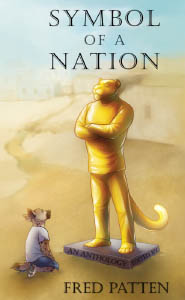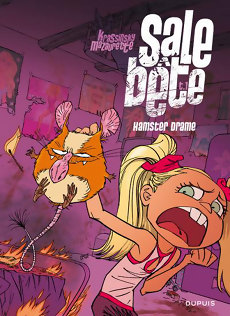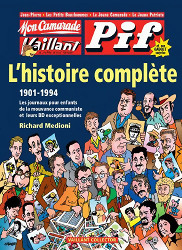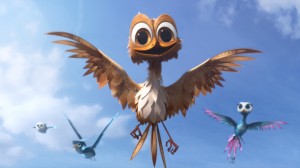Belgium
Movie review: 'Chickenhare and the Hamster of Darkness' (2022)
Posted by dronon on Fri 5 Dec 2025 - 20:12 Chickenhare and the Hamster of Darkness (trailer) is a 90-minute 3D kids animated adventure-comedy film. Released in 2022, it's important to note that this is an nWave Studios producion, a Belgian company whose output since 2008 has consistently ranged from "awful" to "thoroughly meh".
Chickenhare and the Hamster of Darkness (trailer) is a 90-minute 3D kids animated adventure-comedy film. Released in 2022, it's important to note that this is an nWave Studios producion, a Belgian company whose output since 2008 has consistently ranged from "awful" to "thoroughly meh".
It's rare for their average IMDB score to go higher than 6 out of 10. This one was directed by Benjamin Mousquet and Ben Stassen, written by Dave Collard, and was very loosely inspired from graphic novels by Chris Grine.
I think Chickenhare has been the studio's... "best" work so far, but that's not saying much. Their second-best would probably be either The House of Magic (2013) or Son of Bigfoot (2018).
What I find fascinating about Chickenhare is that it's just on the edge of being okay. Most of its elements use well-worn tropes that you typically get in kids films, but other things are... different. Cheerfully absurd. It's not taking itself entirely seriously. It's solidly aimed at a young audience - but there's this odd, subtle undercurrent that only adults might notice, when they're not being bored. It's really difficult to put into words.
Symbol of a Nation slated for Anthrocon release
Posted by Fred on Sat 10 Jun 2017 - 20:44 Symbol of a Nation, edited by Fred Patten, is launching at Anthrocon 2017 in Pittsburgh, Pennsylvania over the June 29-July 3 five-day weekend.
Symbol of a Nation, edited by Fred Patten, is launching at Anthrocon 2017 in Pittsburgh, Pennsylvania over the June 29-July 3 five-day weekend.
Symbol of a Nation is an all-original anthology of 11 short stories and novelettes featuring the anthropomorphized official animal (or bird) symbols of nations. This is designed to appeal to both s-f & fantasy fans, and fans of political science.
Below are the list of countries and animals that will be included in this set:
Belgium – lion
Chile – Andean condor
Denmark – mute swan
Italy – wolf
Malaysia – tiger
Mauritius – dodo (extinct)
Namibia - oryx
Romania - lynx
Singapore - lion
Spain - bull
U.S.A. – bald eagle
Vietnam – water buffalo
The History of nWave's Furry Features
Posted by Fred on Tue 2 May 2017 - 19:21Since Dronon recently posted the trailer for “Bigfoot Junior” on Newsbytes, it seems like a good time to take a deeper look into nWave Pictures. Their main animation studio is located in Brussels, Belgium, while their regional office in Burbank, California has been working diligently to get its pictures distributed theatrically in English in North America for the past decade. They do get theatrical releases in much of the rest of the world-- but usually have to settle for them going direct-to-DVD as "kid’s cartoons" in the United States. Despite being “family” movies, they’re good ones, and they do feature talking animals. Let's take a look at their history in the animated featured film business to date.
nWave was founded by director Ben Stassen in 1994. Its first animation projects were for amusement park attractions and video games. Their first theatrical feature, “Fly Me to the Moon”, which was about housefly astronauts, was released in January 2008.
Music video: Tiësto and JAUZ's 'Infected' at Tomorrowland
Posted by GreenReaper on Mon 18 Jul 2016 - 17:48Boomer The Dog's paper fursuit was ridiculed by some… but was he just ahead of the curve?
Judge for yourself as you watch this music video sponsored by Budweisser brewer AB InBev for Belgian electronic music festival Tomorrowland – not to be confused with Disney's film or theme parks of the same name – featuring Tiësto and JAUZ's "Infected". [Creativity Online]
Can 'The Wild Life' get any wilder?
Posted by Fred on Fri 18 Mar 2016 - 00:39Anthro animal animated features are sneaking up on us faster than we can announce them.
Here is the trailer for the 90-minute The Wild Life, due for American release on September 9, 2016. It’s very loosely based on Robinson Crusoe from the island's animals’ point of view; Tuesday the parrot, Carmelo the chameleon, Scrubby the goat, Rosie the tapir, Pango the pangolin and others. The animals decide to “help” the human castaway and his dog. Ha, ha.
This has already been released throughout Europe in February as Robinson Crusoe, and it will have been seen in most of the rest of the world by the time we get it. If nWave Pictures is involved, it’s a Belgian production. nWave’s animation studio is in Brussels. It does good work. nWave produced the 2013 The House of Magic, which was scheduled for an American theatrical release – it’s set in Boston – up to the last minute. It ended up as a direct-to-DVD kids’ release.
Let’s hope that The Wild Life has better luck.
Green is Yellow
Posted by Mink on Thu 27 Nov 2014 - 02:58From Variety: “Wrekin Hill Entertainment has acquired all North American rights to Christian De Vita’s 3D animated feature Yellowbird from TeamTO and Haut & Court. The film… is written by Antoine Barraud and Guilhem Lesaffre with Cory Edwards and based on artwork by Benjamin Renner (Ernest and Celestine).” Seth Green (Greg the Bunny, Robot Chicken) stars as the voice of Yellowbird, “…a teenage bird so scared to venture out into the world that he nearly misses the fun of discovering who he really is.” Other voices include Dakota Fanning (Charlotte’s Web), Danny Glover, Elliott Gould, Jim Rash, and Christine Baranski. The distributors have been slowly trickling the film out to North American theaters, so take a look around for it — or else visit the Yellowbird Facebook page. Meanwhile, the English trailer is up on YouTube.
Animation: 'Thunder and the House of Magic'
Posted by Fred on Mon 18 Aug 2014 - 23:56Jerry Beck has just announced on his Animation Scoop website that Shout! Factory will release the December 2013 Belgian-made (for Christmas 2013 release in French-speaking parts of Europe) 85-minute animated feature The House of Magic, retitled Thunder and the House of Magic and dubbed into English, in theaters in U.S. “selected cities” on September 5. The selected cities include New York, Los Angeles, Atlanta, Boston, Houston, Miami/Ft. Lauderdale, San Francisco, and Washington, DC. Shout! Factory is primarily a DVD releaser, so presumably this will become a generally-available DVD release shortly after that.
Under either title, this looks like a kids’ CGI animated feature that furry fans will enjoy, with an anthropomorphized kitten, rabbit, mouse, dog, doves, and lots of Toy Story-type toys saving an elderly stage magician’s house from being sold out from under him by a greedy nephew. The movie is made by Brussels’ nWave Pictures, which made the 2010 A Turtle's Tale: Sammy's Adventures and the 2012 A Turtle's Tale 2: Sammy's Escape from Paradise features that have already become children’s DVDs in America.
Review: 'Sale Bête', by Maïa Mazaurette and Jean-Paul Krassinsky
Posted by Fred on Wed 15 May 2013 - 15:35 I thank Lex Nakashima again for ordering these books from Amazon.fr and loaning them to me.
I thank Lex Nakashima again for ordering these books from Amazon.fr and loaning them to me.
Hmmm. Well, you certainly gain a vocabulary of current French slang from reading this series. Ordi = PC. Les etrons = turds. La clope = cigarette. L’enfoire = bastard. Catin = whore. Lolcat = Sorry; that one’s American.
Filthy Beast (or Dirty Beast) Volume 1, “Hamster Catastrophe”, introduces the Bastogne family; father (unnamed), mother Vivienne, older daughter Elizabelle, younger daughter Amandarine, and cat Clarky. Their world is like ours, except that there is a factory, La Fabrique, that makes living pets to order.
An animal isn’t improvised here. We guarantee domestic PERFECTION.
Customers can order a bunny, a cat, a puppy, a ferret, a squirrel, a tarantula – anything – made to their choice. Calm to playful. Dominant to submissive. Quiet to expressive. Solitary to social. Stupid to intelligent. Brave to cowardly. Energetic to lazy. There is a long list. Eleven-year-old Amandarine whines that one of her classmates got a blue pony with wings for HER birthday, that her parents had designed it to graze on only the weeds in the garden … Their housecat Clarky comes from La Fabrique. He’s pale pink dotted with darker pink hearts; he’s intelligent; he loves everybody; and so on.
So the Bastognes decide to get Amandarine a designer pet for her birthday.
“Sale Bête. T.1, Hamster Drame”, January 2012, hardbound €10.60 (54 pages).
“Sale Bête. T.2, On Ira Tous au Charadis”, April 2013, hardbound €10.60 (48 pages).
Marcinelle, Belgium, Editions Dupuis; both written by Maïa Mazaurette, illustrated by Jean-Paul Krassinsky.
For French-readers: Comics going back to 1901?
Posted by Fred on Sun 3 Mar 2013 - 15:05 Well, not exactly. You are probably vaguely aware that there have been a lot of French-language funny-animal bandes dessinées going back decades. Chlorophylle the dormouse. Attila the dog. Billy the Cat. Gai-Luron the hound. Poussy. Inspector Canardo. Chaminou the cat. Jungle Fever. The Centaurs. (Are centaurs funny animals?) Yakari is a little North American Indian boy who meets lots of talking/magic animals. Pif the dog and Hercule the cat. The Schtroumpfs/Smurfs aren’t exactly funny animals, but they aren’t exactly humans, either. Not to mention many famous supporting characters: Tintin’s dog Snowy, Spirou’s squirrel Spip. The long-tailed marsupilami started out as a supporting character in the adventures of Spirou and Fantasio, eventually getting his own series.
Well, not exactly. You are probably vaguely aware that there have been a lot of French-language funny-animal bandes dessinées going back decades. Chlorophylle the dormouse. Attila the dog. Billy the Cat. Gai-Luron the hound. Poussy. Inspector Canardo. Chaminou the cat. Jungle Fever. The Centaurs. (Are centaurs funny animals?) Yakari is a little North American Indian boy who meets lots of talking/magic animals. Pif the dog and Hercule the cat. The Schtroumpfs/Smurfs aren’t exactly funny animals, but they aren’t exactly humans, either. Not to mention many famous supporting characters: Tintin’s dog Snowy, Spirou’s squirrel Spip. The long-tailed marsupilami started out as a supporting character in the adventures of Spirou and Fantasio, eventually getting his own series.
What you may not be aware of is that these characters did not appear in their own magazines. They were serialized, usually two pages at a time, in long-running weekly magazines, more like newspaper Sunday supplements in America; and then reprinted in their own albums. Spirou. Tintin. Pilote. Vaillant. Le Journal de Mickey.
